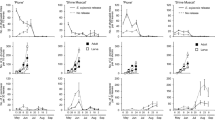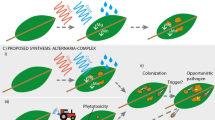Abstract
Twenty-eight spotted potato ladybird beetle (Henosepilachna vigintioctopunctata) is a polyphagous pest that infests various crop plants of the family Solanceae. It extensively infests Withania somnifera, a high-value medicinal plant of this family. Both the beetle and W. somnifera leaf spot pathogen (Alternaria alternata) are individually found to be closely associated with the foliar damage and may rarely infest the same leaf simultaneously. Beetles fed on diseased leaves showed high pupal and larval mortality. Furthermore, the development of the larvae into pupa and from pupa to adult was also delayed, which in turn delayed the overall development of the insect. Adult emergence from pupae is also reduced in the insects fed on diseased leaves. Since the fungal pathogen is host specific to W. somnifera and does not infect the other solanaceous crops, therefore this fungal stain can be used in designing bio-control strategies for the other solanaceous plants frequently infested by the beetle.




Similar content being viewed by others
References
Chatterjee S, Srivastava S, Khalid A, Singh N, Sangwan RS, Sidhu OP, Roy R, Khetrapal CL, Tuli R (2010) Comprehensive metabolic fingerprinting of Withania somnifera leaf and root extract. Phytochemistry 71:1085–1094
Christias C, Dara A, Kaliafas A, Chrysanthis G (1999) Assessment of a new fungal pathogen for the biological control of aphids. In: Canard M, Beyssat-Arnaouty V (eds) Proceedings of the first regional symposium for applied biological control in Mediterranean countries, Cairo, Egypt, October 25–29, 1998, 73–76. Canard, Toulouse, France
Christias C, Hatzipapas P, Dara A, Kaliafas A, Chrysanthis G (2001) Alternaria alternata, a new pathotype pathogenic to aphids. Biocontrol 46:105–124
Dillard HR, Cobb AC, Lamboy JS (1998) Transmission of Alternaria brassicicola to Cabbage by flea beetles (Phyllotreta cruciferae). Plant Dis 82:153–157
Endrinal DM, Geling MS (1940) Septoria leaf spot of tomato. Philipp Agric Sci 29:593–610
Ghosh SK, Senapati SK (2001) Biology and seasonal fluctuation of Henosepilachna vigintioctopunctata Fabr. on brinjal under terai region of West Bengal. Indian J Agric Res 35:149–154
Kimura N, Tsuge T (1993) Gene cluster involved in melanin biosynthesis of the filamentous fungus Alternaria alternata. J Bacteriol 175:4427–4435
Mandai SC (1971) A note on the host range of Epilachna beetle, E. vigintioctopunctata in Bihar. Allahabad Fmr 45:187–188
Mathur AC, Srivastava JB (1964) Epilachna vigintioctopunctata F. (Coccinellidae: Coleoptera) as a defoliator of some Solanaceous medicinal plants. Indian. J Entomol 26:246
Mohansundaram M, Uthamaswamy S (1973) A note on the Epilachna spp. commonly found in Tamil Nadu with observation on the host range and distribution. Sci Cult 39:305–306
Pati PK, Sharma M, Salar RK, Sharma A, Gupta AP, Singh B (2008) Studies on leaf spot disease of Withania somnifera and its impact on secondary metabolites. Indian J Microbiol 48:432–437
Podova M, Dobias J, Nemec P (1977) Inhibitory effect of fungal metabolites on the development of Drosophila melanogaster. Biologia 32:657–662
Rajagopal D, Trivedi TP (1989) Status, bioecology and management of Epilachna vigintioctopunctata (Fab.) (Coleoptera: Coccinellidae) on potato in India: a review. Trop Pest Manag 35:410–413
Sharma A, Pati PK (2011) First record of 28-spotted ladybird beetle, Henosepilachna vigintioctopunctata (F.) infesting Withania somnifera (L.) Dunal in Punjab Province of Northern India. Pest Tech 5:91–92
Sharma A, Sharma I, Pati PK (2011) Post-infectional changes associated with the progression of leaf spot disease in Withania somnifera (L.) Dunal. J Plant Pathol 93:397–405
Takano Y, Kubo Y, Kawamura C, Tsuge T, Furusawa I (1997) The Alternaria alternata melanin biosynthesis gene restores appressorial melanization and penetration of cellulose membranes in the melanin-deficient albino mutant of Colletotrichum lagenarium. Fungal Genet Biol 21:131–140
Widodo N, Kaur K, Shrestha BG, Takagi Y, Ishii T, Wadhwa R, Kaul SC (2007) Selective killing of cancer cells by leaf extract of ashwagandha: identification of a tumor-inhibitory factor and the first molecular insights to its effect. Clin Cancer Res 13:2298–2306
Wilson K, Cotter SC, Reeson AF, Pell JK (2001) Melanism and disease resistance in insects. Ecol Lett 4:637–649
Acknowledgments
Financial assistance from Council for Scientific and Industrial Research (CSIR), Government of India, New Delhi, India is duly acknowledged.
Conflict of interest
The authors declare that they have no conflict of interest.
Author information
Authors and Affiliations
Corresponding author
Additional information
Communicated by S.T. Jaronski.
Rights and permissions
About this article
Cite this article
Sharma, A., Thakur, A., Kaur, S. et al. Effect of Alternaria alternata on the coccinellid pest Henosepilachna vigintioctopunctata and its implications for biological pest management. J Pest Sci 85, 513–518 (2012). https://doi.org/10.1007/s10340-012-0432-3
Received:
Accepted:
Published:
Issue Date:
DOI: https://doi.org/10.1007/s10340-012-0432-3




